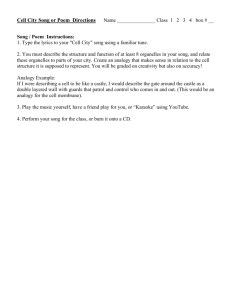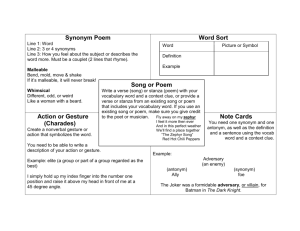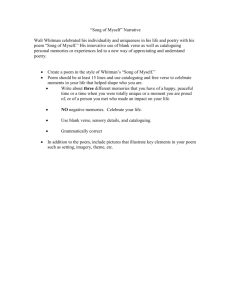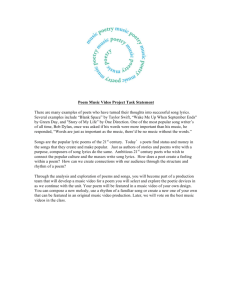Poetry Recitation Template: Analyze & Present Poems
advertisement
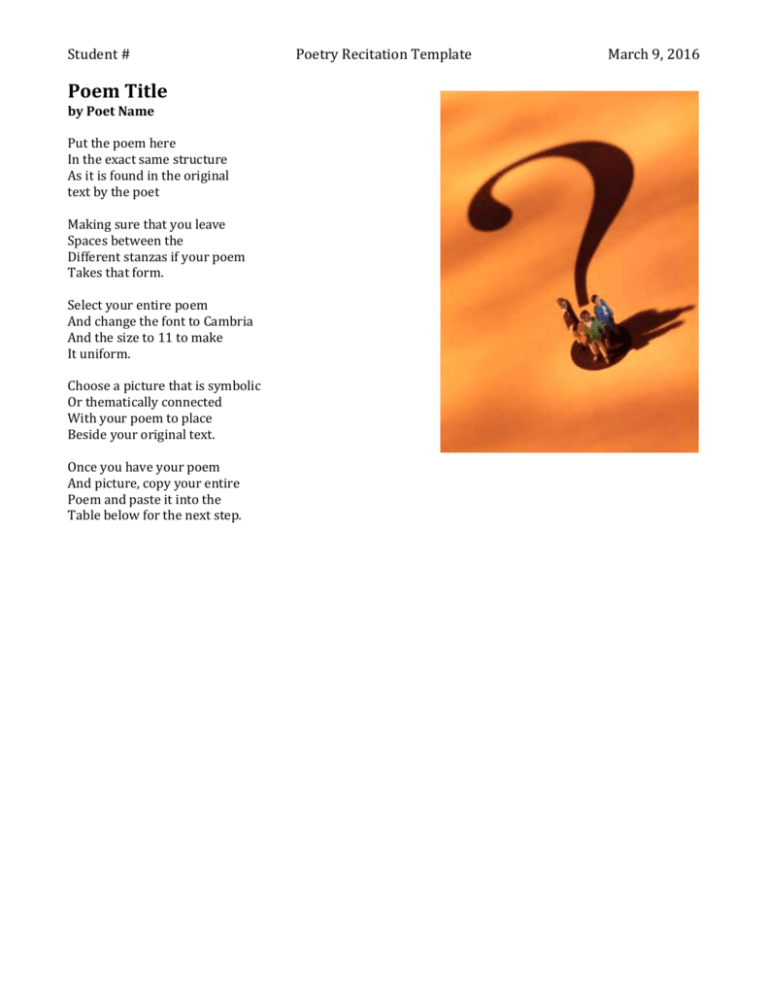
Student # Poem Title by Poet Name Put the poem here In the exact same structure As it is found in the original text by the poet Making sure that you leave Spaces between the Different stanzas if your poem Takes that form. Select your entire poem And change the font to Cambria And the size to 11 to make It uniform. Choose a picture that is symbolic Or thematically connected With your poem to place Beside your original text. Once you have your poem And picture, copy your entire Poem and paste it into the Table below for the next step. Poetry Recitation Template March 9, 2016 Student # Poetry Recitation Template Poem Title by Poet Name Paste your poem here Exactly as it appears on The first page above For the next step 5 10 15 20 In the left hand column Put in a line number For every fifth line of the poem As you read over the poem Again, highlight and colour Code different poetic devices that You find in the lines Start looking for as many Poetic devices as you can find With the list on the right As your starting point. After you have finished Colour coding your poem, It will be time to start Doing your paragraph below March 9, 2016 Alliteration Allusion Antithesis Apostrophe Assonance Consonance Euphemism Hyperbole Imagery Metaphor Onomatopoeia Oxymoron Personification Simile Symbol Student # Poetry Recitation Template March 9, 2016 In x by y there is a lot of z which is important because of A In “Poem Title” by Poet Name there is a lot Dominant Poetic Devices which is important because of “BIG IDEA” Paragraph Title Here is where you will plan and type a paragraph about your poem. Your focus should be on how the poet’s message that is related through the use of various poetic devices and choices that were made. Use textual support (quotes) to help prove your points/ideas. There are samples below for help. Student # Poetry Recitation Template Siren Song by Margaret Atwood This is the one song everyone would like to learn: the song that is irresistable: the song that forces men to leap overboard in squadrons even though they see the beached skulls the song nobody knows because anyone who has heard it is dead, and the others can't remember Shall I tell you the secret and if I do, will you get me out of this bird suit? I don't enjoy it here squatting on this island looking picturesque and mythical with these two feathery maniacs, I don't enjoy singing this trio, fatal and valuable. I will tell the secret to you, to you, only to you. Come closer. This song is a cry for help: Help me! Only you, only you can, you are unique At last. Alas it is a boring song but it works every time. March 9, 2016 Student # Poetry Recitation Template Siren Song by Margaret Atwood 5 10 15 20 25 This is the one song everyone would like to learn: the song that is irresistible: the song that forces men to leap overboard in squadrons even though they see the beached skulls the song nobody knows because anyone who has heard it is dead, and the others can't remember Shall I tell you the secret and if I do, will you get me out of this bird suit? I don't enjoy it here squatting on this island looking picturesque and mythical with these two feathery maniacs, I don't enjoy singing this trio, fatal and valuable. I will tell the secret to you, to you, only to you. Come closer. This song is a cry for help: Help me! Only you, only you can, you are unique March 9, 2016 Hyperbole Allusion Alliteration Metaphor Imagery At last. Alas it is a boring song but it works every time. The Frog and the Scorpion Aesop's ancient fable of "The Frog and the Scorpion" cleverly details that sometimes it is difficult for a creature to resist its own innate nature. In the lyric poem, "Siren Song, that also containts elements of a narrative, Margaret Atwood shows the depth that can be found when a mythical creature and its natural abilities are viewed from a modern perspective. Atwood's use of allusion, through taking the first person perspective of one of Ulysses' Sirens, reminds the listener/reader that these women from mythology and fables were created by the male writers of those eras and are therefore enslaved by their nature and not by their gender: whether they be gorgon, harpy, siren, sorceress, or shrew. Atwood, through alliteration, allusion, imagery, and apostrophe, creates pathos for the Siren who is enslaved by her nature (just as the fabled scorpion) and vilified as a result of her creator's own mysogyny. As the mythical Siren sings “the song / that is irresistible” to men we are reminded of Homer’s ancient Greek myth Ullyses (2-3) These birdlike creatures lured men to their deaths on the rocks as their “boring song…works every time” (26-27). Atwood furthers this magical call of the siren by alluding to soldiers an invasion; even though the men can “see the beached skulls,” they still jump to their deaths (6). By using these mythical and historical references, the woman of the poem is given a deep pathos; she cannot resist her own abilities and nature and is just as doomed as those she lures to their deaths, and just as much as the frog who was killed by the scorpion. Student # Poetry Recitation Template Sonnet 116 by William Shakespeare Let me not to the marriage of true minds Admit impediments. Love is not love Which alters when it alteration finds, Or bends with the remover to remove: O no! it is an ever-fixed mark That looks on tempests and is never shaken; It is the star to every wandering bark, Whose worth's unknown, although his height be taken. Love's not Time's fool, though rosy lips and cheeks Within his bending sickle's compass come: Love alters not with his brief hours and weeks, But bears it out even to the edge of doom. If this be error and upon me proved, I never writ, nor no man ever loved. March 9, 2016 Student # Poetry Recitation Template Sonnet 116 by William Shakespeare 5 10 Let me not to the marriage of true minds Admit impediments. Love is not love Which alters when it alteration finds, Or bends with the remover to remove: O no! it is an ever-fixed mark That looks on tempests and is never shaken; It is the star to every wandering bark, Whose worth's unknown, although his height be taken. Love's not Time's fool, though rosy lips and cheeks Within his bending sickle's compass come: Love alters not with his brief hours and weeks, But bears it out even to the edge of doom. If this be error and upon me proved, I never writ, nor no man ever loved March 9, 2016 Paradox & Antithesis Metaphor Personification Imagery Alliteration Hyperbole Paradox Love Knows No End If one can fall in love, then is it possible for one to fall out of love? According to William Shakespeare's immortal lyric "Sonnet 116," often better known by its opening line "Let Me Not to the Marriage of True Minds," such an occurrence would only indicate that one was never in love at all. Shakespeare notes through his continued use of the contradiction of paradox and antithesis that love does not change simply because a person changes, but instead is "an ever-fixed mark" that will not be shaken by the storms that can occur in life (2-3, 5). His clever metaphorical conceit is love can guide one to happiness just as the stars in the sky can be used to guide lost ships,(7). However, Shakespeare is clear to note that falling out of love simply because beauty has faded over time and "rosy lips and cheeks" have lost their blush, clearly indicates love was never there at all; merely infatuation or, more likely, lust. Only true love is eternal, yet in Shakespeare's whimsical and paradoxical style, he dares anyone to prove him otherwise: if such is the case then he will have "never writ, nor no man ever loved" ; as any fool will ironically realize, Shakespeare certainly wrote, and no one could truly deny that genuine love knows no end (14). Perhaps, if everyone treated love with this level of reverence and respect, then there would probably be fewer marriages, yet certainly fewer divorces as well.



